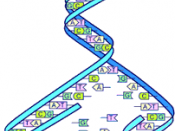Samuel Castilow
Prof. Maddy
Anthropology 2346
On June 26, 2000, former President Bill Clinton was joined with the then British Prime Minister, Tony Blair, to unveil the next biggest advance in science, genome mapping. This is the process of physically being able to map out a human gene to see the chemical base pairs that make up ones DNA, from a physical and functional standpoint. As this huge scientific advancement continued on and it started to become available from anybody to get their genomes read at home, many people started to see some risks with genome researching, whether it was a social, technological or ethical risk.
In 1990, the Ethical, Legal, and Social Implications (ESLI) was founded in order to recognize and be able to address issues that were brought up by the Human Genome Project that could possibly affect individuals, families and society. The ESLI gets about five percent of the Human Genomes Project annual budget to help address any problems that arise.
Just like any other research program, gene sequencing raised questions about whether it was reasonable to be spending as much money as they are in a time, when research is in a time of having limited funds. Problems are raised when critics say that the high cost is not being justified. They believe that with all the money that is going towards genome research that some of that money could be going towards smaller research groups that do their research more efficiently. But as time is advancing along, the prices to have a persons genome sequenced have greatly decreased. A company can have someone DNA mapped from prices ranging from $1,000 to $4,000. Many companies believe that they will be able to do it in the future for less that $1,000 and that anytime...


